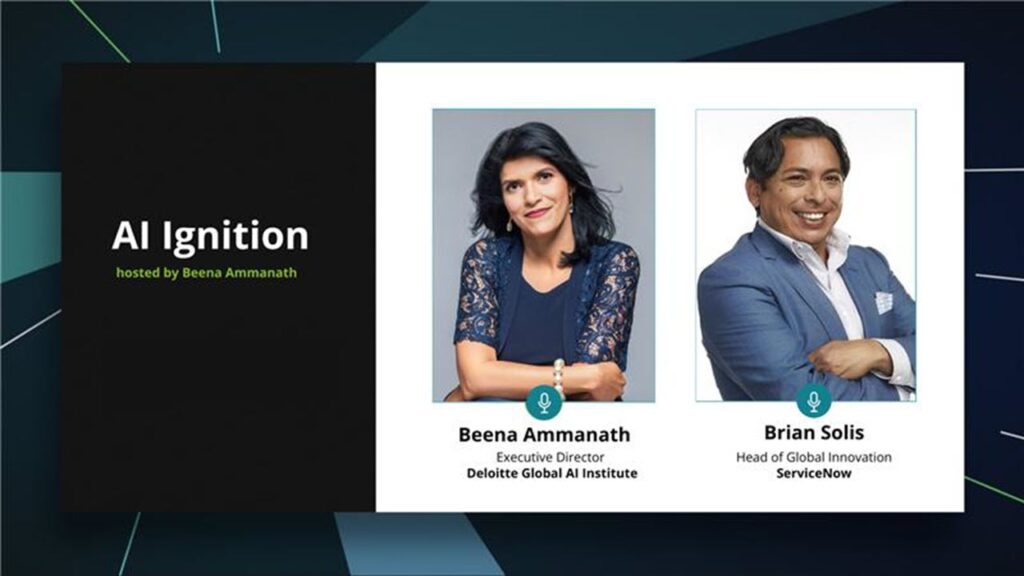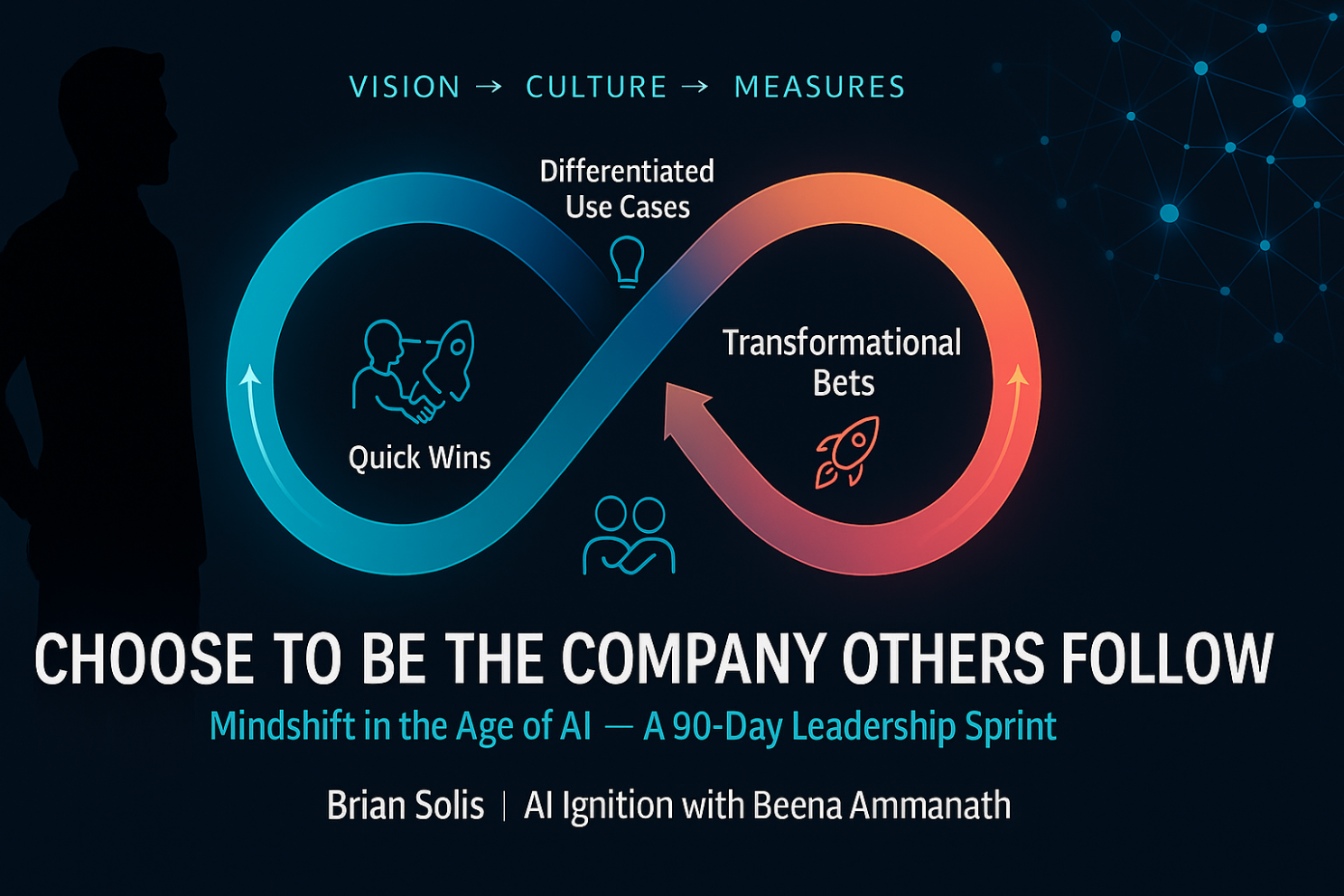
Technology moves at its own pace, adoption moves at the pace of culture.
I joined Deloitte’s AI Ignition podcast with Beena Ammanath, Executive Director, Deloitte Global AI Institute, to talk about why AI feels different from past waves of technology, what it asks of leaders, and how we can turn disruption into a competitive advantage.
Beena opened by reminding us of a simple truth from Deloitte’s research: “technology moves at its own pace, but the adoption of the technology in an organization moves at the pace of the organization’s culture.” That became the backbone of our conversation.
Please watch/listen here.
Why AI Feels Different (and What to Do About It)
AI triggers something deeper than the usual automation cycle.
After watching the “Godfather of AI” Geoffrey Hinton’s sobering exchange with Steve Bartlett on Diary of a CEO about the future of jobs and humanity, I had to pause and think about our next steps. His vision for the future of work wasn’t, let’s just say, cheerful or terribly motivating. But fear without agency is paralyzing. It’s easy to spiral into dystopia. I believe the better move, however, is to treat those scenarios as inputs for planning, to reverse engineer those potential scenarios to help people take steps to reshape their future and the future of work, now.
Leaders and employees are still figuring out how to collaborate with AI. Most organizations are trying small automations or pilots, but “very few are reimagining what their future organization… can look like in partnership with artificial intelligence.”
That’s the work. We can shape what comes next.
I accept that there’s a lot to learn and a whole lot to unlearn moving forward.
Transformation begins with a mindshift.
To have that mindshift is to give yourself the gift of learning and unlearning, to see what you couldn’t see before, to do what you couldn’t do before.
We are all tempted to manage the future with the logic of the past. That only produces iteration. AI deserves, and requires, innovation, the pursuit of creating new value.
Beena underscored the same point from Deloitte’s research: technology moves at its own pace, but adoption moves at the pace of culture and change. If we do not evolve how we think and work, the technology cannot deliver its promise.
Begin with a Motivational Future State
Before roadmaps, start with vision. I shared how storied entrepreneur and venture capitalist Vinod Khosla’s provocation, “there’s only 200 people in the world that understand what’s really happening right now,” pushed me to go deeper.
Your job is to make that 201 inside your own company.
Start by defining a motivational future state: an inclusive and inspiring vision where you want to be in 18–24 months with AI and how you’ll know you’re on track along the way. The goal is to make that vision tangible and aspirational, one where people see themselves in it and believe they play a role in bringing that vision to life. Then reverse-engineer the steps and the measures (OKRs/KPIs) people can align to, and get to work.
This demands a mindshift:
“To transform your thinking and your organization, you have to start by disrupting yourself.”
It means unlearning patterns that default to incrementalism. Otherwise we “limit our opportunities and our outcomes to iteration and not innovation.”
Culture Is the Catalyst
I’ve spent years in transformation work. After studying waves of innovation, digital transformation and now AI business transformation, consistently, I found that the biggest catalyst andinhibitor in driving change is culture. Beyond vision and mission statements, behind earnings calls and publicity, people need to see themselves in the story and as part of story from beginning to end. They have to believe they have agency in the outcome, and share a vision, incentives, and motivation, with leaders and teams across the organization.
“If you can’t articulate what the future looks like… then you can’t have a culture that brings that AI transformation to life.”
Measure What Matters
Execution turns vision into velocity.
Beena pressed on execution. My answer: break the portfolio into three lanes in parallel, not sequentially. This was inspired by Gartner research:
- Quick Wins to build confidence and momentum.Differentiated Use Cases that create advantages (not just an “AI-powered status quo”).Transformational Bets that alter trajectory.
If you can’t describe the vision and measures for each lane, you’re not ready to execute.

The Workforce: From Roles to Outcomes
Anxiety persists because people don’t see where they fit. So we cannot leave the workforce behind.
Build on the vision, then audit your workforce against your articulated future motivating state: which capabilities are missing, where do you excel, what can AI agents do today and tomorrow, what requires human orchestration, and how success will be measured?
Don’t tell people to “use AI for deeper work” without defining what deeper work is, how to get the skills, and how it will be recognized.
“What we can do is start to get some tangible elements…then look at the workforce and audit it…what are the jobs we need, what are the skills we need, how are we going to get people there, and how are we going to balance them with AI and train them to be able to execute?”
Fear and uncertainty recede when people know what success looks like and how they will be supported to get there.
Align Progress Against an AI Maturity Index
We also discussed industry patterns. From our latest ServiceNow AI Index, we saw AI maturity regress year over year by nine points. This was a huge finding in that, on average, companies scored 35 out of a possible 100 (with 100 being the most mature). Last year, the average score was 44.
We learned that this year, companies expressed that AI was moving too fast. In just the last three years, we’ve experienced the overnight rise of generative AI, then AI agents, and now the agentic enterprise. Organizations struggle with the speed of change and the governance necessary to safely and effectively pilot and scale.
Even so, I’m seeing bold pilots in manufacturing (robotics, computer vision, and physical AI); Beena noted strong acceleration in financial services and life sciences/healthcare, aided by rich data and maturing use cases.
The pattern is clear: governance plus vision plus experimentation accelerates maturity.
Dream bigger than optimization
Optimization is table stakes.
Short term, expect a lot of iteration… automation… optimization. And that’s good. It’ important to show how to improve what we did yesterday, better, less expensive, more scalable, tomorrow. That’s how enterprises adopt technology. Necessary, but not sufficient at the speed and scale we’re observing among AI-Native and AI-First companies.
The real opportunity is that AI offers the opportunity to do what you didn’t do yesterday. I foresee org charts where we see AI roles alongside employees and digital teammates. Done right, that yields not only linear growth but also exponential outcomes.
Using AI to rethink customer relationships
One practical example is CRM.
A practical opportunity: the “own” side of customer relationships. So many companies invest in acquisition motions and supporting infrastructure, but treat retention as a scrutinized line item…that is until customers threaten to walk away. But the own side is where value compounds.
“It’s less expensive and more strategic to keep a customer happy than it is to try to acquire a new customer.”
AI can change that. We’ve long treated service and success as cost centers. But no one wakes up hoping to talk to a chatbot or sit in a contact-center queue. With AI agents dedicated to customers, we can deliver real outcomes fast, reduce complexity, and convert service into growth.
AI can turn service and success from cost centers into growth engines, with agents dedicated to customers, integrated journeys, and outcomes that feel as valued as the day they signed.
Closing: Choose to Be the Company Others Follow

This is your moment to decide whether AI happens to your organization or throughit. The difference is a leader willing to say, “I don’t know what I don’t know,” and then act with conviction to fill in the blanks.
Here’s my challenge to you, wherever you are in the organization, a 90-day sprint to make the future tangible:
Week 1: Leaders, write your one-page motivational future state. Invite input. Name the customer and employee outcomes they will feel in 12–18 months. Share it with your leadership team.
Week 2–3: Stand up an AI Governance & Value Office that pairs risk with product, ops, and finance. Set non-negotiable metrics for adoption, experience, velocity, and revenue impact.
Week 4–6: Launch your three-lane portfolio: 3 quick wins (confidence and capacity), 2 differentiated use cases (what your peers aren’t doing), and 1 transformational bet (what changes your trajectory).
Week 7–8: Audit roles and skills against the vision. Publish a mindful human + agent org chart that empowers and augments your workforce, not automate them out. Fund learning paths tied to recognition and rewards. Document your potential for exponential output not possible otherwise. This is your future moat.
Week 9–10: Reinvent the “own” side of your business with CRM, shifting from a cost-center mindset to an infinite growth center. Pick one critical customer journey and deploy agents to deliver end-to-end personalized experiences and outcomes customers would choose again.
Week 11–12: Hold an Unlearning Review. Retire one legacy KPI, one legacy process, and one legacy belief that no longer serves the vision. Celebrate what you moved from iteration to innovation.
Put dates on a calendar. Name owners. Allocate budget. Report progress to your board monthly. You’ll discover that once the vision is explicit and measured, momentum compounds. Put words to it, articulate learnings and a future-motivating state, and culture follows.
Obviously this is fast, too fast for most to willingly embrace. So what? We don’t need to wait for perfect timelines or clarity to lead. We need the courage to begin, the discipline to measure, and the humility to learn and unlearn along the way…especially in the face of the unknown. I
Define what happens next.
If you take this 90-day challenge, tell me what you learned and what you built, or at least, did differently.. Let’s make this the year we chose transformation over hesitation and formulaic automation, to become the companies others follow.
AIdapt or Die!
Mindshift | Speaking | Newsletter
The post Igniting AI Transformation: How to Future-Proof Your Company in the Age of AI appeared first on Brian Solis.

